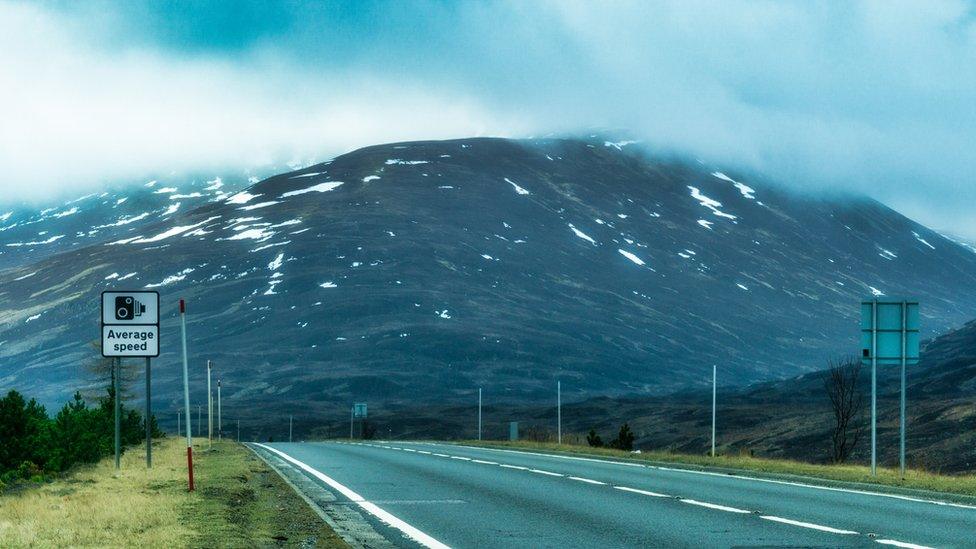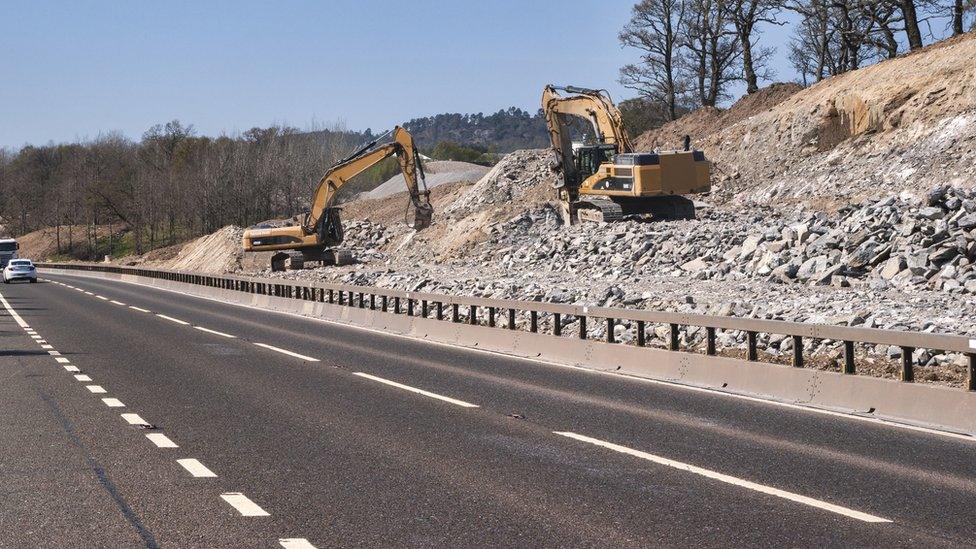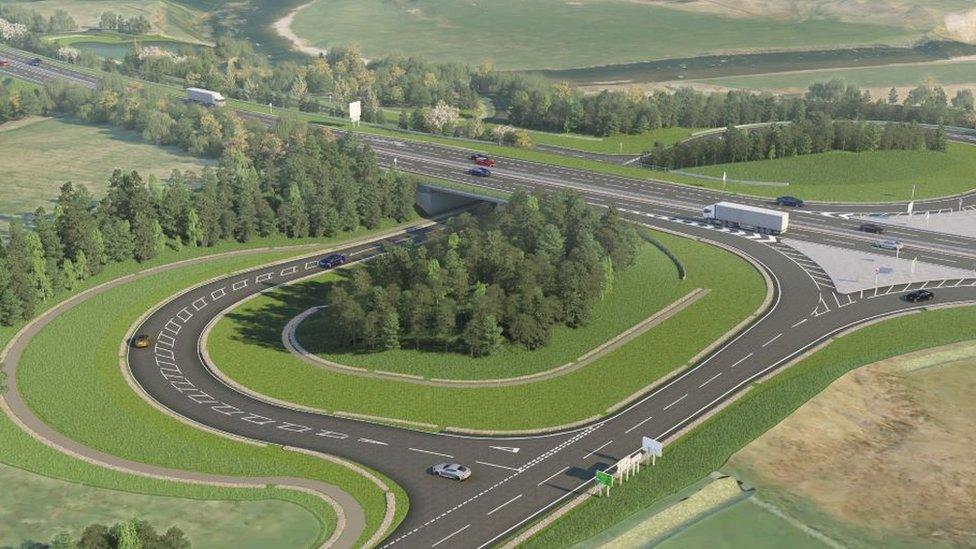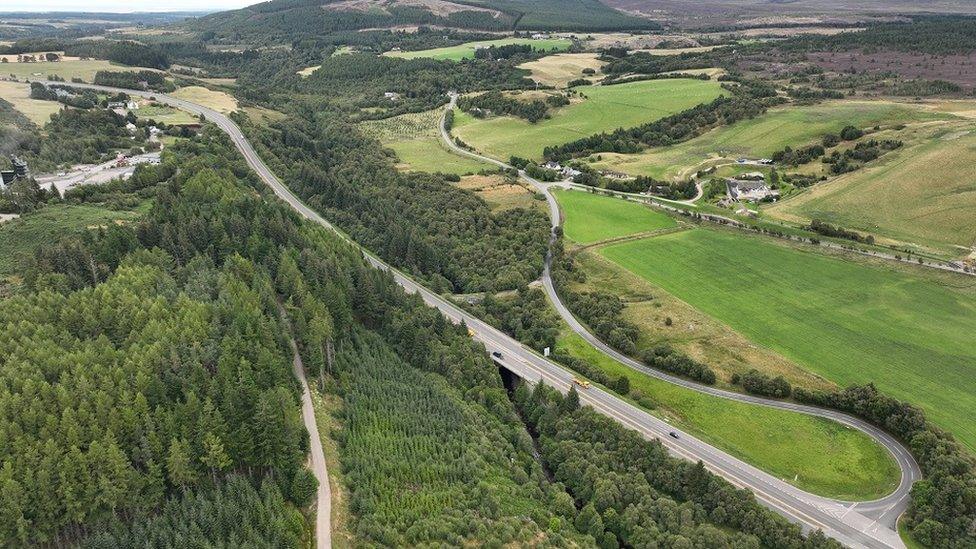A9 dualling project delayed by 10 years until 2035
- Published

The roads project aims to tackle single carriageway sections between Inverness and Perth
Completing the dualling of the A9 between Inverness and Perth has been delayed by 10 years until 2035.
Transport Secretary Mairi McAllan said a new rolling programme of improvements was "achievable" and there would be "no let up" in the work.
But opposition MSPs said communities had been waiting since SNP manifesto commitments in 2007 and 2011 to see the road upgraded by a target date of 2025.
The government said in February that finishing by 2025 was "unachievable".
Two sections of single carriageway totalling 11 miles (18km) of road have been upgraded over the past decade - but 77 miles of the route has still to be dualled.
Ms McAllan told Holyrood on Wednesday that fully dualling the route would make it safer and reduce journey times.
She said communities living along the route should have confidence a new rolling programme would fully complete the job by the end of 2035.
She told Holyrood a new hybrid way of funding the road-building project would be used, with some of the construction work involving private investment using a Mutual Investment Model developed by the Welsh government.
Ms McAllan said the total cost was estimated at £3.7bn at April 2023 prices, which she said was the equivalent of £2.45bn at April 2008 prices.
She said this was well within the original cost estimate of £3bn in 2008.
Ms McAllan said: "Under this new plan, by the end of 2030 we anticipate that nearly 50% of the A9 will be open as dual-carriageway, rising to 85% by the end of 2033 and eventually 100% by the end of 2035.
"This means we will see significant benefits from the dualling programme years ahead of that backstop and 2035.
"The approach that I have set out means that the Highlands can have confidence that the considerable benefits of the A9 dualling programme will be delivered and in full."

The project has seen two sections of single carriageway dualled so far
She also pledged that there will be "no let up" when construction starts on Tomatin to Moy next year, and offered her "heartfelt sympathies and condolences to anyone who has lost a loved one or been injured in collisions on the A9".
Scottish Conservative MSP Murdo Fraser said communities in Perth and Kinross and the Highlands had already waited too long for improvements to the road.
He added: "Throughout that period, too many lives have needlessly been lost and more will die as a result of the delays we have heard about today.
"At best we will be waiting another 12 years for this project to be completed, and that is the most optimistic outcome we can hope for."
Labour's Alex Rowley said the SNP first committed to dual the A9 in 2007.
He added: "With the new date of 2035 for completion between Perth and Inverness, some 28 years after the initial promise, one has to wonder how on earth can the Cabinet Secretary say with a straight face that the Highlands can have confidence?"
SNP backbencher Fergus Ewing, who has been a vocal critic of the Scottish government's failure to meet its original targets for dualling the road, said he would continue to remain sceptical until he sees diggers on the road.
He added: "There must be no more slippage, no more delays and no more broken promises."
A9 safety campaigner Laura Hansler said she welcomed changes to how the project would now be progressed.
She told BBC Radio Scotland's Drivetime programme: "On the surface of it, it sounds fantastic.
"What is most welcome is the change to the procurement procedures."
But Ms Hansler said she still had concerns over the length of time for completing each of the remaining sections.
A Holyrood inquiry has been examining the delays to the project and has called for evidence from former First Minister Nicola Sturgeon and her successor Humza Yousaf.

Expected completion dates of the remaining sections under the new programme, subject to contract and funding processes, are:
Tomatin to Moy - by the end of 2027
Tay Crossing to Ballinluig - by the end of 2028
Pitlochry to Killiecrankie - by the end of 2030
Pass of Birnam to Tay Crossing - by the end of 2032
A9 North (Crubenmore to Kincraig and Dalraddy to Slochd) - by end of 2033, at the earliest
A9 Central (Killiecrankie to Glen Garry, Glen Garry to Dalwhinnie and Dalwhinne to Crubenmore) - by end of 2035, at the earliest

The A9 is Scotland's longest trunk road and often described as the spine of the Scottish road network.
It runs about 230 miles (370km) from Scrabster, near Thurso on the north Highland coast, to near Dunblane in central Scotland. The A9 then continues to near Falkirk.
The Inverness to Perth stretch is one of the busiest on the A9, and has been the scene of numerous fatal accidents in recent years.
The Scottish government has spent almost £500m on improvements so far.
Among the challenging sections left to be upgraded is the area around the 1,315ft (401m) Slochd Summit south of Inverness.
The first major revamps of the A9, in the 1970s and 1980s, included bypasses of more than a dozen towns and villages - but most of the road has remained single carriageway.
- Published15 December 2023
- Published29 November 2023

- Published9 August 2023
